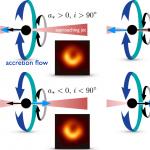Paper of the month: Origin of the Asymmetric Ring around M87's Black Hole

April 18, 2019 by Bruno Martin
On 10 April 2019 the Event Horizon Telescope (EHT) released the first images of the supermassive black hole located in the centre of the Messier 87 (M87) galaxy [1]. In these images reconstructed from radio-wave observations, the black hole shadow is surrounded by an asymmetric ring-like structure, which is brighter in the south than the north. In Ref. [2], the EHT Collaboration investigates the physical origin and implications of the observed asymmetric ring.
The working hypothesis assumes that the central object in M87 is a spinning Kerr black hole with mass M and dimensionless spin a* ≡ Jc/(GM2), where J, G, and c are, respectively, the black hole angular momentum, gravitational constant, and speed of light. The spin a* can vary between -1 and 1, and its negative values imply that the angular momentum of the accretion disc formed by the matter rotating around the black hole and that of the black hole are anti-aligned. Performing extensive computer simulations based on general relativistic magnetohydrodynamic (GRMHD) models for the accretion flow, Ref. [2] finds that the EHT results are consistent with the black hole hypothesis. It is worth noting that the obtained results exclude models with a* = 0, i.e., a non-spinning black hole in the centre of M87.
The asymmetry in the ring's brightness can be explained by a combination of motion in the source and Doppler beaming. As a simple example, let's consider a luminous ring rotating with certain speed and having an angular momentum vector inclined at a viewing angle i > 0° to the line of sight. Then the side of the ring approaching Earth is Doppler boosted, while the receding side is Doppler dimmed, which produces a brightness contrast. What concerns the motion in the source, the relationship between black hole spin and disk angular momentum a affects the resulting ring asymmetry in the way shown in Fig. 1. As can be seen, the observed asymmetry implies that the black hole spin is pointing away from Earth, i.e., black hole rotates in a clockwise direction as viewed from Earth.
Future EHT campaigns will provide better constraints, in particular, on the width of the ring. The asymmetry in the ring, being controlled by the black hole spin, is expected to remain in the southern half of the ring. The EHT together with complementary experiments targeting black holes, such as LIGO and Virgo, open a promising avenue of improved tests of gravity in its most extreme regimes.
References
-
K. Akiyama et al. [Event Horizon Telescope Collaboration], Astrophys. J. 875 (2019) no.1, L1.
-
K. Akiyama et al. [Event Horizon Telescope Collaboration], Astrophys. J. 875 (2019) no.1, L5.
Figure 1: Illustration of the effect of black hole spin (black arrow) and disk angular momentum (blue arrow) on ring asymmetry [2]. If the black hole spin axis is aligned with that of disc angular momentum (the case considered here), then the observed asymmetry implies that the black hole spin is pointing away from Earth (rotation of the black hole is clockwise as viewed from Earth). Inclination i is defined as the angle between the disk angular momentum vector and the line of sight.


